Huawei TaiShan 200 OCP NIC 3.0 Slots
There are two OCP NIC 3.0 slots on the rear of the motherboard. One of them is unpopulated in our system.
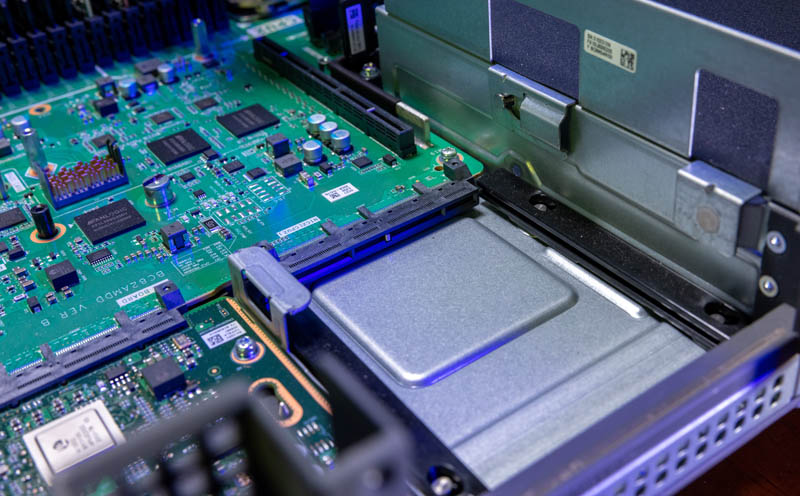
The second one holds what is perhaps the most interesting OCP NIC 3.0 card we have seen, at least in the quad 1GbE configuration.
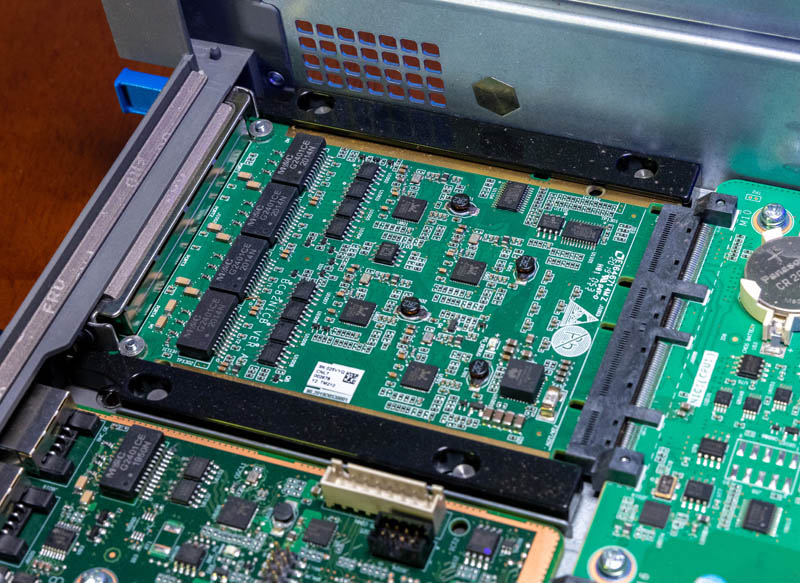
This card does not use an Intel i350 NIC to provide four 1GbE ports as we see in most servers. We also do not have an array of Intel i210 NICs that we see on low-end servers. There are no Broadcom or Marvell equivalents either. Instead, we get four Realtek NICs.
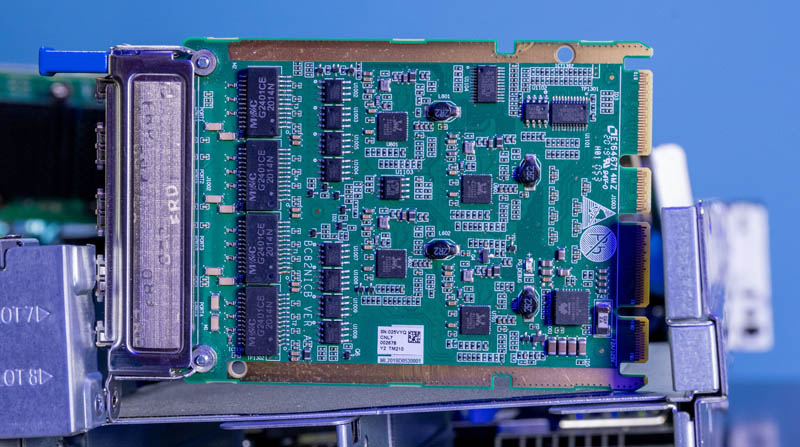
This card has four RTL8211 1GbE NICs. That is somewhat laughable as the card is also set up with an OCP NIC 3.0 x16 connector designed for many times that bandwidth. Normally we see RTL8211 NICs on low-end desktop PCs such as in the sub $200 segment. It is very uncommon to see these in dual-socket servers except sometimes as PHYs for a management port.
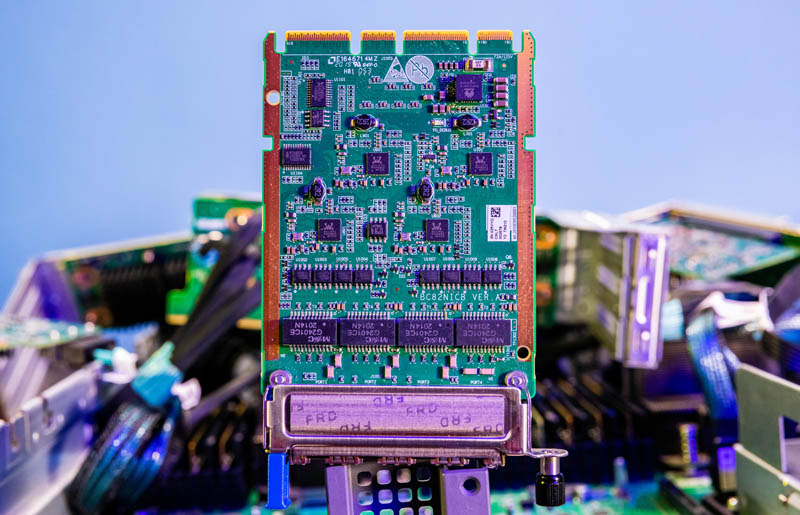
On the topic of management, that is equally as intriguing. One can see that the management board is between the two OCP NIC 3.0 slots, and that is what we will look at next.
Huawei TaiShan 200 Management
The management board has the BMC as well as provides features such as the rear I/O’s management port, RJ45 serial port, USB ports, and VGA port. It is not designed to be as easily swapped as the OCP NIC 3.0 cards, but one can see it is using a similar edge connector. This is more designed to be customized during the server’s build.
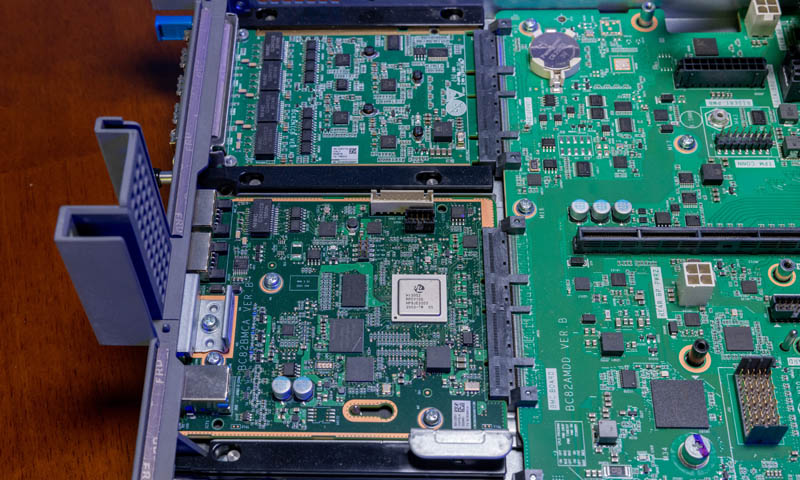
The card is most notable because of the chip that is on it. This is a HiSilicon Hi3052. Our best guess is that this is the BMC. We can see a Realtek NIC, storage, and DRAM next to it, similar to what we would see with an ASPEED series BMC.
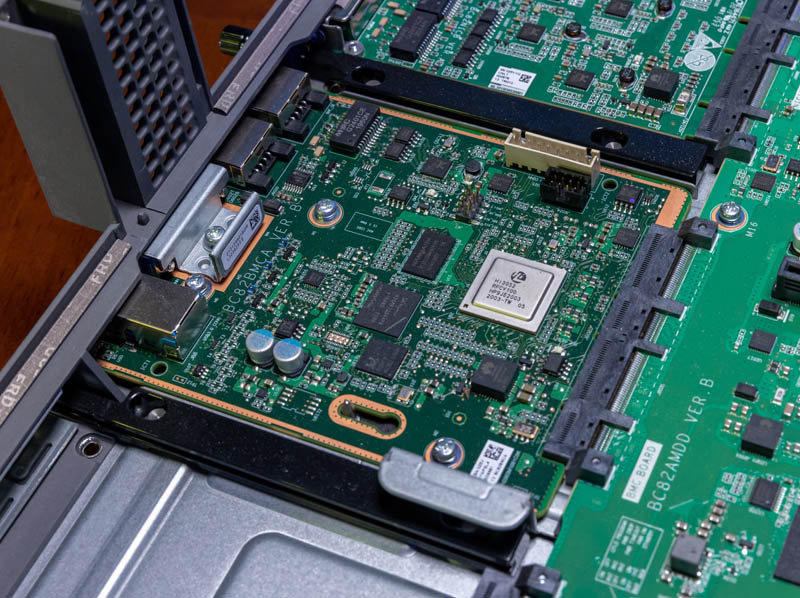
There are some strange things about this chip. One is that searching “HiSilicon Hi3052” does not yield any results on Google. Simply “Hi3052” gets us HI-3052 a hexene copolymer for injection molding. This appears to be a chip without documentation.
Next, let us look at the block diagram and the Kunpeng 920 CPUs.




Interesting read. Very strange that the BMC chip is undocumented. Furthermore in the blockdiagram they talk about a different model chip.
I did spot a small error in the writing:
Lenovo servers are probably a step above Huawei, then this Huawei server.
You may not have gotten far enough along in this test for the question be applicable, but does STH routinely monitor network-connected devices for “unexpected” traffic?
@Joeri – I made that a bit clearer. I agree it was chewy wording.
@Bob Niland – we are not tooled to check like a security research firm is. I would expect what you are looking for is rather sophisticated and we do not have a team that can sift through live traffic for days.
Patrick, please, stop filming hanging hardware.
There is no details visible and earlier way of showing thing was a lot better.
Please return to blue doors.
Actually it’s 25-bay backplane.
That’s a catchy headline!
But I fail to find any substance behind it: why exactly is it both forbidden and banned? And from where and under which penalty?
And just in case it’s explained in the video: I never watch those. I come to STH precisely because it can be read.
@abufrejoval
Huawei is sanctioned in the US and you can’t import it legally.
Wow these comments are off the charts. Such an out of control crowd of nerds going squirrelly over circuitry from abroad. I am lost for words. How could you keep your comments section open even after addmjtting you expected such an obvious culling of naysayers … …. …
;)
The worst thing is the cluelessness of the outright IP theft from them. HP had lots of patents on Moonshot and now they co-developed a machine with Fujitsu that looks at lot like the Huawei here. Aren’t y’all tired of the Chinese theft of intellectual property?
I fully expected more Engrish text in this server, but there is no American Megatrands or similar text to be found.
The lscpu result shows 4 NUMA nodes. This is a 2P server, so is that BIOS configuration option or is it just the way the CPU is designed?
What’s a “retimer” in this context? Its a legitimate chip for re-timing signals, but in this usage might be typo ?
@chris s I just wanna know what they’re not showing
@criggie that’s what they’re saying. you’ll see servers like dell’s and others use pcie retimers when they’re taking signals from pcie slots and then converting them to cables. there’s signal loss when you go cpu mobo->riser so then when you go cpu mobo->riser->long cable->front->nvme back plane->nvme SSD you need to boost the signal. a lot of servers use pcie retimers because of this. there’s also loss not just because of distance but also they’ve got loss from each connector
“HUR DUR Evil chinese communist theft of intellectual property !
-Written from my iPhone”
LOL
Sorry Yankees, we Chinese have surpassed you. Talk all you want about theft. You stole earlier tech from us: guns, paper, gunpowder, silk, steel, kite , etc
If it is banned how was it imported?
@ dalong Ning
We stole from you lol… Chinese business and government would steal and clone your grandma if they had a chance and could make profit!
No you have not surpassed us… our cpus, phones, cars and etc are alot better then the crap your country makes.
@Jay the funny thing is there has been 100s of cases where you “Chinese” work for many tech companies and have been caught stealing and sharing what “We” make, if your tech is so superior then please answer this, what do you guys need with anything we have created?
Only reason it’s banned in USA is that Huawei CPUs are secure and do not have CIA bookmarks, like Intel and AMD. Not even taking about backdoor controller Microsoft Pluton.
Loving these comments. There is a reason why the world needs Chinese chips. Just hope for a peaceful future. May be biased because I’m engaged to a wonderful Chinese person.
Huawei makes everything better than any company in the US can make.
I love seeing folks trying different solutions. Sometimes it works and tech gets better. I wonder if Huawei’s choices will have an impact.